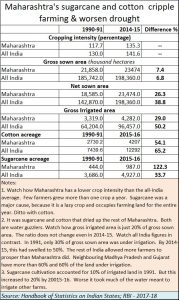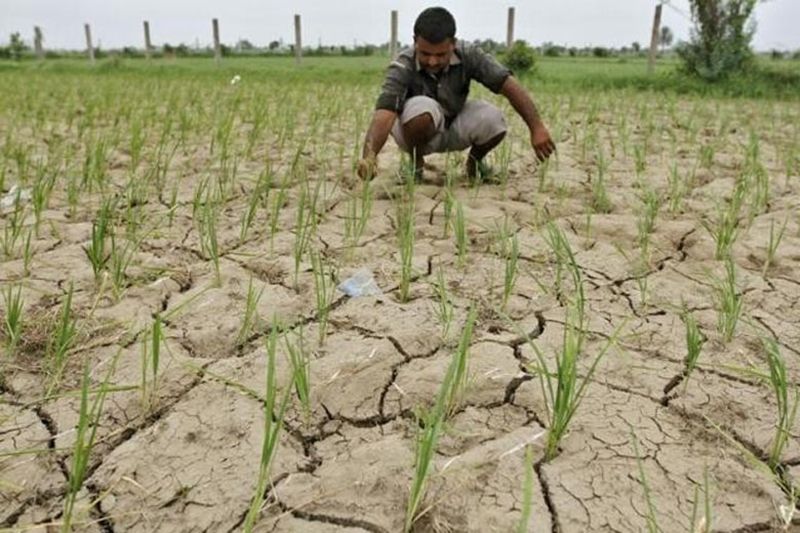https://www.freepressjournal.in/analysis/is-maharashtra-abetting-drought-farmer-distress/1392278
Maharashta promotes water scarcity and abets farm suicides
Last week, media headlines screamed out news that nearly 71% of the state of Maharashtra had registered a drop of more than a metre of groundwater compared to the five-year average. This was stated by the latest survey of the state’s Groundwater Survey and Development Agency (GSDA).
 Soon thereafter there were cries about drought affected villages. Currently, almost two-thirds of the state is being classified as drought prone, hence eligible for sorely needed aid.
Soon thereafter there were cries about drought affected villages. Currently, almost two-thirds of the state is being classified as drought prone, hence eligible for sorely needed aid.
Rather stupidly, the state announced just a few days ago its decision to levy a 10% surcharge (https://www.freepressjournal.in/mumbai/maharashtra-10-p-surcharge-to-foot-state-billfor-solar-pumps/1388448) on each unit of power consumed by industrial and commercial consumers to cover the cost of Rs 825 crore subsidy on solar pumps. The state had decided to provide a lakh solar pumps to farmers (https://www.freepressjournal.in/mumbai/maharashtra-solar-pumps-for-one-lakh-farmers-get-nod/1376911).
The move was ill-advised – even stupid — on two counts. First, it increased the burden on business units already reeling under the high costs of power tariffs. Second, by giving solar pumps to farmers and incentivising their purchase through subsidies, the state would deplete ground water even faster.
When normal power supply is used, the farmer switches off the pump to avoid paying additional power charges. With solar pumps, there will be no power consumption cost. So the pumps will continue to pump water from the ground all through the day. That will be disastrous for ground water management. Someone has not advised the state government properly, and thus deserves to be sacked.
In fact, the state’s entire approach to water management has been terrible. Consider the chart alongside. Maharashtra has 4.3 million hectares of gross irrigated area (according to RBI estimates). Much of it is taken up by sugarcane and cotton. Almost 4.2 million hectares are under cotton cultivation, which is water guzzling, and 987,000 hectares by sugarcane, another water intensive plant (http://www.asiaconverge.com/2018/10/bitter-tales-of-sugar-and-ethanol-in-maharashtra/). Thus, both crops together account for a huge portion of gross irrigated land. Where the farmer cannot get water through canals, he opts for pumps and groundwater reserves.
What is worse is that while cotton accounted for just 2.7 million hectares in 1990-91, this has been allowed to swell to 4.2 million hectares by 2015-16. This recklessness was true of sugarcane as well. Its acreage was allowed to swell from 444,000 hectares to 987,000 hectares over the same period.
The result was simple. Almost all the land that had irrigation facilities were grabbed by farmers growing sugarcane and cotton, backed by tremendous political patronage.
Compounding this is the fact that the state has very little water. So, there has always been an inbuilt incentive for politicians not to allow irrigation to spread to the rest of Maharashtra. Thus, while neighbouring Gujarat and Madhya Pradesh have over 60% and 70% of their cultivable land under irrigation, Maharashtra has the dubious distinction of having just 18% of its gross sown area under irrigation. Sadly, in spite of spending crores of rupees, this percentage has increased from 15% to 18% since 1990-91. Clearly, by restricting irrigation, water resources are grabbed by the privileged and the powerful.
This is nothing short of misgovernance and even culpable murder.
The latter charge is justified because just the first three months of 2018 saw almost 696 farmer suicides in Maharashtra. The National Crime Records Bureau of India reports 5,650 farmer suicides in 2014. The highest numbers were in 2004 when as many as 18,241 farmers committed suicide. According to media reports the period Jan-Oct 2017 saw around 2,414 farmer suicides.
Effectively, the state first allows water to be stolen from the rest of the state. It then allows its favoured people to make pots of money at the expense of other farmers. Since agricultural income is tax free, the rich farmers go laughing to their respective banks, while the cost of subsidising the distressed farmers falls on common tax payers like you and me.
So when farmers die, instead of taxing water consumption, and thus limiting the use of water by water guzzling crops, the state chooses to tax common people. Taxing farmers on the basis of crop cul;ti8vation isn’t very difficult. Satellite and drone mapping can provide very accurate estimates on tax payable per acre.
Had crop specific water taxes been introduced, the impetus to expand the irrigation network would have been greater. If irrigation networks had reached more villages, they would not have depleted groundwater reserves. There would have been less farm distress. Hopefully fewer farmer suicides would have taken place.
That so many farmers were allowed to die – year after year — is terribly unfortunate, even criminal.
Someone should go to jail – even the gallows — for this callousness.





































COMMENTS